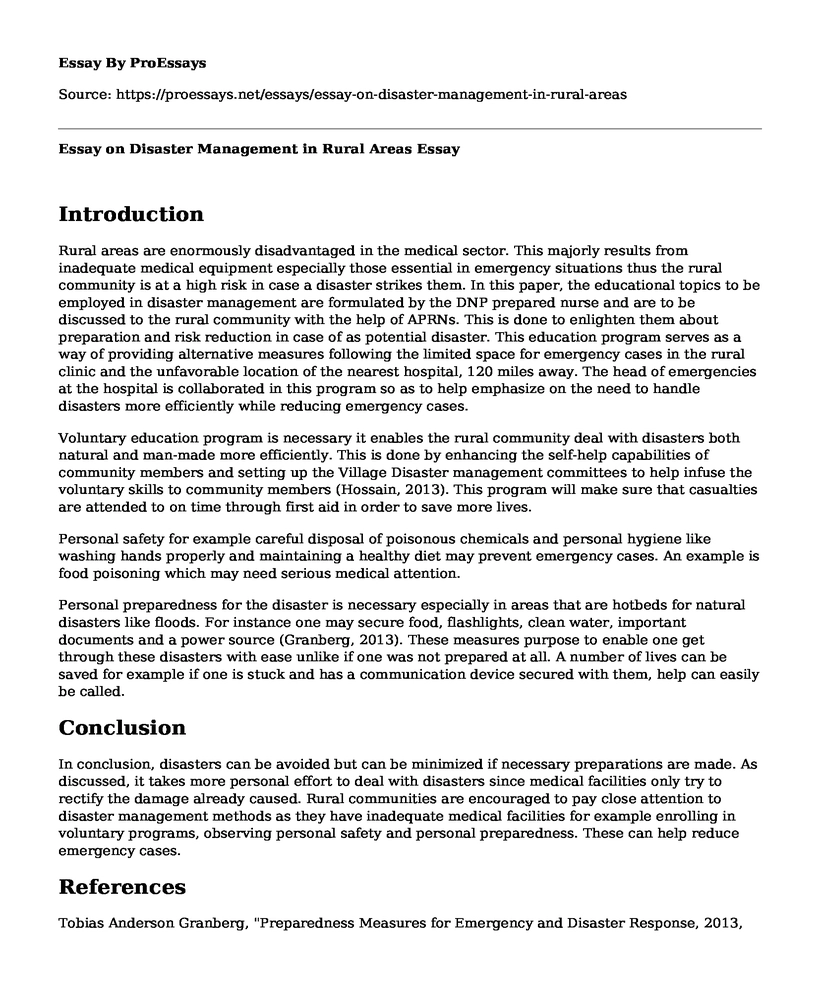Introduction
Rural areas are enormously disadvantaged in the medical sector. This majorly results from inadequate medical equipment especially those essential in emergency situations thus the rural community is at a high risk in case a disaster strikes them. In this paper, the educational topics to be employed in disaster management are formulated by the DNP prepared nurse and are to be discussed to the rural community with the help of APRNs. This is done to enlighten them about preparation and risk reduction in case of as potential disaster. This education program serves as a way of providing alternative measures following the limited space for emergency cases in the rural clinic and the unfavorable location of the nearest hospital, 120 miles away. The head of emergencies at the hospital is collaborated in this program so as to help emphasize on the need to handle disasters more efficiently while reducing emergency cases.
Voluntary education program is necessary it enables the rural community deal with disasters both natural and man-made more efficiently. This is done by enhancing the self-help capabilities of community members and setting up the Village Disaster management committees to help infuse the voluntary skills to community members (Hossain, 2013). This program will make sure that casualties are attended to on time through first aid in order to save more lives.
Personal safety for example careful disposal of poisonous chemicals and personal hygiene like washing hands properly and maintaining a healthy diet may prevent emergency cases. An example is food poisoning which may need serious medical attention.
Personal preparedness for the disaster is necessary especially in areas that are hotbeds for natural disasters like floods. For instance one may secure food, flashlights, clean water, important documents and a power source (Granberg, 2013). These measures purpose to enable one get through these disasters with ease unlike if one was not prepared at all. A number of lives can be saved for example if one is stuck and has a communication device secured with them, help can easily be called.
Conclusion
In conclusion, disasters can be avoided but can be minimized if necessary preparations are made. As discussed, it takes more personal effort to deal with disasters since medical facilities only try to rectify the damage already caused. Rural communities are encouraged to pay close attention to disaster management methods as they have inadequate medical facilities for example enrolling in voluntary programs, observing personal safety and personal preparedness. These can help reduce emergency cases.
References
Tobias Anderson Granberg, "Preparedness Measures for Emergency and Disaster Response, 2013, Humanitarian and Relief Logistics: Research Issues, Case Studies and Future Trends, 59-75.
Md. Anwar Hossain,"community participation in disaster management."AntrocomOnline Journal of Anthropology 2013, vol. 9.n. 1-ISSN 1973-2880.
Cite this page
Essay on Disaster Management in Rural Areas. (2022, May 16). Retrieved from https://proessays.net/essays/essay-on-disaster-management-in-rural-areas
If you are the original author of this essay and no longer wish to have it published on the ProEssays website, please click below to request its removal:
- Leadership Concepts and Practice Essay
- Essay on Working Effectively With Others
- Importance, Relevance and Purpose of Business Law Paper Example
- Essay Sample on Leadership Skills Development
- Employees and Organizational Change Paper Example
- Essay Example on Organizational Ethics: Building an Ethical Culture
- The Vitality of Personal Data Privacy: Trust & Security - Free Paper Example







